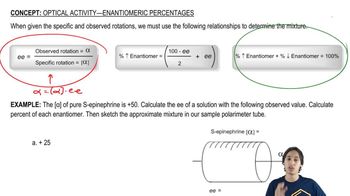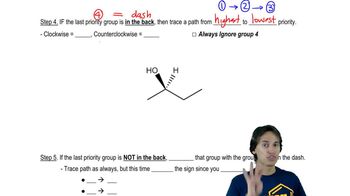Here are the essential concepts you must grasp in order to answer the question correctly.
Enantiomers
Enantiomers are a type of stereoisomer that are non-superimposable mirror images of each other. They have the same molecular formula and connectivity but differ in the spatial arrangement of atoms. This difference can lead to distinct physical properties, such as smell, as seen with (+)-carvone and (−)-carvone, which smell like caraway seed and spearmint, respectively.
Recommended video:
How to solve for the percentage of each enantiomer.
Optical Activity
Optical activity refers to the ability of chiral compounds to rotate the plane of polarized light. This property is measured using a polarimeter, which quantifies the angle of rotation. Each enantiomer will rotate light in opposite directions; thus, a polarimeter can help distinguish between the (+) and (−) forms of carvone based on their specific rotations.
Recommended video:
Mutorotation and Optical Activity
Chirality and R/S Nomenclature
Chirality is a property of a molecule that has a non-superimposable mirror image, often due to the presence of a chiral center, typically a carbon atom bonded to four different groups. The R/S nomenclature system is used to assign configurations to these chiral centers, helping to identify the specific enantiomer. Understanding this system is crucial for determining whether the enantiomer that smells like spearmint is (R) or (S) carvone.
Recommended video:

 Verified step by step guidance
Verified step by step guidance Verified video answer for a similar problem:
Verified video answer for a similar problem:



 5:43m
5:43m